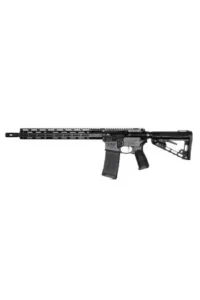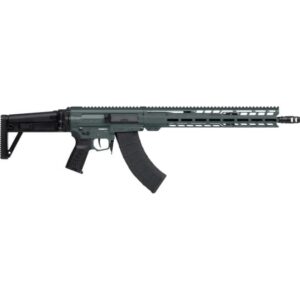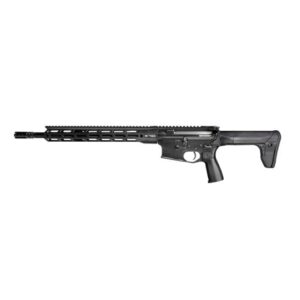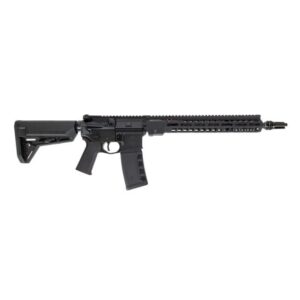Before we get to our Glock 26 VS. M&P Shield showdown, let me tell you how this all came about.
A couple days ago my father-in-law and I met with one of his old friends at his personal shooting range. He showed us his collection — among which is a Chinese-made AK-47 clone (the brand is called Norinco), a Rock Island Armory 1911-style pistol chambered in .22 TCM, a Glock 26 Gen4 and an obscure semi-auto pistol that looked so beaten up I didn’t bother checking it out.
What caught my attention was his newest acquisition: a subcompact S&W M&P9 , which he said was the second generation of the M&P line of pistols from Smith & Wesson. I was like wow, it looks like a Glock and it also has “generations” — just another Glock rip-off!
Plastic Guns?!?
In the past I’ve been very vocal about how I don’t like plastic guns. I was brought up shooting only all-steel 1911s and revolvers and I just don’t like them, so I don’t think there’s anything special about this Glock clone.
Also, while I love S&W magnum revolvers (specifically the pre-lock ones) and I’m a huge fan of Jerry Miculek, I don’t like Smith & Wesson as a firearms manufacturer company — and I don’t think I have to explain why as it’s common knowledge (at least among gun rights advocates). So why am I even writing this article?
I think Glocks are ugly, and this Glock-ish clone from Smith & Wesson isn’t a beauty queen either — it does look a bit more proportional compared to the Glock 26, but an officer-size 1911 is just miles away from both in the aesthetics department. I just don’t like plastic guns in general.
This isn’t something I should be busying myself with.
Well, I’m writing this because my father-in-law and that friend of his had an hour-long argument over which pistol is better, the former swears by the M&P9 M2.0 because he thinks it’s easier to conceal and has, among other things, better ergonomics (and like me he doesn’t like Glocks too).
His friend thinks the M&P M2.0 is a great acquisition but Glocks are the be-all and end-all of plastic handguns being they were they were the first (he obviously hasn’t heard of the H&K VP70 but technically he’s right — Glock made plastic handguns the phenomenon that they are today), which makes Glock the authority. That, and Glocks are reliable and perfect, etc.
Whatever one argued, the other had a counter-argument to. Needless to say, they got nowhere.
I’m hoping that by doing research and giving them (and our readers who might be considering getting either of these two pistols as a CCW piece) a non-biased handgun enthusiast’s perspective (I don’t like both, which makes me non-biased), I could help out a little.
Table Of Contents
- Glock 26 VS. M&P Shield – The Tale of the Tape
- The Glock 26 Gen4
- The S&W Shield M&P9 M2.0 Subcompact
- Dimensions
- Accuracy
- Glock 26 VS. M&P Shield – Handling
- Glock 26 VS. M&P Shield – Durability
- Ease of Maintenance
- Caliber Conversions
- Glock 26 VS. M&P Shield – Pricing
- Glock 26 VS. M&P Shield – Customer Support
- Glock 26 VS. M&P Shield – Which one is better then?
- Glock 26 VS. M&P Shield – Conclusion
- Recommended Reading
Glock 26 VS. M&P Shield – The Tale of the Tape
| Glock 26 Gen4 | S&W Shield M&P9 M2.0 Subcompact |
|---|---|
| Caliber: 9mm | Caliber: 9mm |
| Overall Length: 163mm / 6.41 in. | Overall Length: 154.94mm / 6.2 in. |
| Height: 106 mm / 4.17 in. | Height: 114.3 mm / 4.5 in. |
| Width: 30 mm / 1.18 in. | Width: 30 mm / 1.18 in. |
| Barrel Length: 87 mm / 3.42 in. | Barrel Length: 79 mm / 3.1 in. |
| Weight with empty mag: 615 g. / 21.71 oz. | Weight with empty mag: 518.8 g. / 18..3 oz. |
| Frame Material: Polymer | Frame Material: Polymer |
| Slide Material: Steel | Slide Material: Stainless Steel |
| Finish: Melonite | Finish: Armornite |
| Action: “safe action” DAO, striker-fired | Action: DAO, striker-fired |
| Barrel Rifling: Polygonal (octagonal), 1/9.84" twist | Barrel Rifling: Lands-and-grooves, 1/10" twist |
| Magazine Capacity: 10 (optional 15/17/33) | Magazine Capacity: 7, 8 |
| Bore axis: 32mm / 1.26 in. | Bore axis: ? |
If you went through all the figures on the table above you probably noticed that the bore axis measurement for the M&P9 is missing. That’s because I searched everywhere online, even talked to a certain Wayne from Smith & Wesson’s customer service, but I got nothing. More on this later.
The Glock 26 Gen4
In 1995 Glock began production of the models Glock 26 and Glock 27. Both are pretty much the same subcompact pistols with the only difference between them being their calibers — the former is chambered for the weaker but faster 9mm while the latter is chambered for the stronger but slower .40 S&W.
A year later, both pistols were introduced in the US and they’ve become some of the most popular plastic guns on the market since.
Glock Reliability
All Glock subcompacts share the same defining physical attribute: they have a short fat grip and a short slide, i.e. they’re all ugly as sin (to me at least). Other than their appearance, they work pretty much like their bigger compact and full-size brothers — they’re all reliable.
And that Glock pistols are reliable is a gross understatement — as discussed in all the previous rounds of our series of these Handgun Showdown write-ups, they’ve been tortured to hell and back, and back to hell and back. They never stop working.
The Glock 26 is no exception. Just skim through these Google results and you’ll see why, and while you’re at it, maybe you’d want to read what this guy did to his. I mean I’d sooner drive a bulldozer over my 1911 — we all know what saltwater does to metal.
I don’t like Glocks as far as aesthetics and I’ve said that a number of times before, but I can understand why there are people who love them so much. It’s because of their legendary reliability.
I personally wouldn’t hesitate to buy one and carry it on my person if I didn’t have my trusty custom 1911 EDC — then again I don’t really like the 9mm that much either so I’d really go for something like a Para Ordnance Warthog in .45 ACP.
The S&W Shield M&P9 M2.0 Subcompact
It was in 2012 when Smith & Wesson introduced the first of their M&P Shield line of plastic handguns and it really gave all their plastic-handgun-manufacturing competitors (the biggest of which being Glock) a run for their money.
In the next three years they would produce more than a million of these pistols. Who knows how many more of these were produced fast forward three more years to today? And there’s one good reason for the M&P Shield’s rise in popularity: it screams value through and through.
While these weren’t nearly as reliable as Glocks as these guys from the Military Arms Channel on YouTube demonstrated from their routine torture tests of sorts, the M&P Shield offered better sights (any factory steel sights on a handgun is better than Glock’s plastic sights in my opinion), better ergonomics and a rather intrusive but newbie-friendly loaded chamber indicator, among other things.
These features along with the more modest price might have mitigated the reliability bit and made the Shield M&P pistols a great alternative to Glocks.
M&P Shield Low Bore Axis
And similarly, M&P pistols also have a low bore axis — the exact measurement for which I unfortunately can’t find anywhere so again, more on this later. And being inspired by Glocks these are also lighter compared to all-steel handguns because of the polymer frame.
But like most any other firearm, the first generation of the M&P Shield line of pistols had issues which, if you’re here to do research, I unfortunately won’t cover as it’s beyond the scope of this article. If you’re so inclined, you can get info on some of those issues from here.
Suffice it to say, fixes were applied to the second generation last year — the full size models being the first to receive generational improvements and later in October of 2017, the same were applied to the subcompact models.
With all the problems ironed out, the newer M2.0 version of all M&P Shield pistols are now an even bigger contender in the huge plastic pistols market.
But with all the things it has going for it, is Smith & Wesson’s subcompact plastic pistol any better compared to Glock’s? We’ll know by comparing them on some key areas.
Dimensions
As far as dimensions, the subcompact M&P9 M2.0 and the Glock 26 Gen4 are relatively similar. While the M&P9 M2.0’s overall length is twenty-one hundredths of an inch smaller and its width at the widest part is nineteen hundredths of an inch smaller, the Glock 26 Gen4’s height from the bottom of the grip to the top rear of the slide is one-third of an inch smaller.
This means that when trying to conceal either pistol, the Glock 26 Gen4 will not print as bad as the M&P9 M2.0.
Typically, a handgun with a shorter grip conceals easier but has two main downsides: it has less ammo capacity and it can be difficult to shoot comfortably and accurately because it can be tougher to hold on to when shooting.
But all generations of Glock 26 can hold at least 10 rounds in the mag, and all are comfortable to shoot and accurate (we’ll dig deeper on these later). The M&P9 M2.0 on the other hand, while it does feel better on the hand because of its longer 18-degree grip area, is bested by the Glock on ammo capacity as it can only hold a maximum of 8 rounds in the mag.
So as far as concealability and height-to-ammo capacity ratio, the Glock 26 Gen4 wins.
Accuracy
There have been numerous accuracy tests done for both pistols online and either was shown to be plenty accurate for a CCW.
Both handguns are easily capable of very tight groups measuring around 2 inches or less from a distance of up to 10 yards which is about the farthest anyone would want to shoot in any self defense scenario.
Granted, these handguns differ in the type of barrel rifling they use and their rifling’s length of twist, but the differences are academic at best and can’t be used to determine how one is more accurate than the other.
So as far as accuracy, it’s a draw.
Glock 26 VS. M&P Shield – Handling
When trying to determine how well a handgun handles, I consider a few things:
- How easy it is to rack the slide (which depends on things like the recoil spring design and how well the slide is fitted to the frame)
- How well it aims (which depends on the installed factory sights and the gun’s natural tendency to point — a function of its point of balance and grip angle)
- How well it handles recoil (which depends on a handgun’s weight relative to the caliber it’s chambered for, the recoil spring’s poundage, and the ergonomics)
- How fast I can do accurate follow-up shots with it (which depends on how well it handles recoil and its trigger action)
This is an area where the S&W M&P9 M2.0 gets a narrow win over the Glock 26.

Glock 26 VS. M&P Shield – Trigger
The M&P9 M2.0’s trigger has a short and quick travel with a tactile and audible short reset and has zero creep. You can really feel it when you’re pulling it as you hit that wall just before it cleanly breaks. This makes it better than the Glock 26’s mushy trigger, something all Glock owners complain about.
Also, the M&P9 M2.0 just feels better in the hand with all the subtle contours on its grip. In contrast, the Glock 26’s grip (and all Glock models’ grips for that matter) has a blocky feel to it which, even when installing any of the back straps included in the box, doesn’t feel anywhere near as good in the hand as the M&P M2.0’s grip.
So as far as handling, the M&P9 M2.0 subcompact wins.
Glock 26 VS. M&P Shield – Durability
There’s no question that both handguns, with enough care, will hold up well against corrosion.

For their M&P line of handguns, Smith & Wesson use a similar proprietary method called Armornite.
Unfortunately, there isn’t too much info available online about this Armornite finish so I can’t tell whether it’s any better than Melonite. All I know is Smith & Wesson has the name trademarked. For this reason (and for another similar one, as we’ll get into later), I would have to give this win to the Glock 26.
Ease of Maintenance
As far as ease of maintenance, the Glock 26 (like all Glocks) can be field stripped in seconds without requiring the use of any kind of disassembly tool — only downside to this is the user has to pull the trigger to field strip the gun, which can be dangerous if there’s a round chambered in it and the user isn’t careful enough to check.
While I’ve done it more than a few times and I’m okay with pulling its trigger for disassembly, I’ve been handling guns for as long as I can remember so I can’t speak for everyone.

Being a 1911 purist I think anyone should be able to disassemble their handgun without any kind of tool so I would have to down-vote the M&P9 because of this — however when comparing it to the Glock 26 requiring its trigger to be pulled to field strip it, I see why some might prefer the former over the latter.
So for ease of maintenance, both having their share of pros and cons, there’s no winner.
Caliber Conversions
Just looking at the chart from Lone Wolf below, we can see that the Glock 26 can be converted to shoot .40 S&W, .357 SIG and .45 GAP.
But there is no available info on caliber conversions for the M&P9 M.20 subcompact, unfortunately. And at the moment there are no third party barrel manufacturers that offer any kind of caliber conversion options for this handgun.
So without belaboring the point, when it comes to caliber conversions, the Glock 26 Gen4 being the more mature platform wins.
Glock 26 VS. M&P Shield – Pricing
The Glock 26 Gen4 retails for $549 on Glock’s website, while the M&P9 M2.0 subcompact retails for $479 on Smith & Wesson’s.
| Product Name | Where to Buy | |
|---|---|---|
 | Glock 26 Gen4 | |
 | M&P Shield |
Glock 26 Gen4
That’s a 14.61% difference in price which means if you’re a little short on $$$ but you want a reliable subcompact CCW you can defend yourself with, it’s a no brainer. You’ll have to go with the M&P9.
M&P Shield
Now if you’re going to factor in the number of mags that come out of the box, the Glock 26 Gen4 comes with three ten-round mags while the M&P9 M2.0 only comes with a 7-round and an 8-round mag. That’s thirty rounds in the mag for the Glock compared to only fifteen rounds for the Smith, a 100% difference in ammo capacity.
That might not affect your decision making too much if you’re only looking for a CCW, but if you want a handgun that conceals well and also doubles as a plinking/recreational piece, that’s when you should really consider getting the Glock 26.
So as far as pricing, it’s a wash. I personally wouldn’t buy either handgun as I, again, just don’t like plastic guns — but if I really had to, I’d go with the Glock.
Glock 26 VS. M&P Shield – Customer Support
This is where I have a gripe about the M&P9 M2.0. Yesterday when I called Smith & Wesson’s customer support phone number and talked to the rep, I was told that they don’t have all the technical info I need. When I sounded like I was really going to be persistent about it, the rep said their engineering team would have all the info but no one shared it with their team.

If I was a potential customer trying to get technical info on a certain company’s product to make a purchase decision and I’m told by that company’s representative (who’s supposed to know stuff about the product) that they don’t have the info I need, I would be quick to decide not to bother with them.
Like how is it possible that no one from Smith & Wesson, with all their marketing dollars being a major player in the firearms manufacturing industry in US, ever bothered to put the bore axis measurement of their M&P guns on their website? Or did they deem that little measurement too trivial to even bother with?
Lack of Information
This also applies to the Armornite finish. Why is it that there isn’t a single source of info about it online? And why bother registering it as a trademark with the USPTO if it isn’t such a big deal? Or maybe some Smith & Wesson marketing exec thought it was just a name that sounded cool and decided to have it trademarked, providing no useful info to any potential customers curious about it?
I can’t help but think that if they’re this apathetic toward potential customers like myself, how much worse could it be if I already bought one of their products and I would need aftermarket support? You can go ahead and do a search on Google about it. While there are a few positive feedback on their customer service, the general consensus is it’s no good.
I’m disparaging Smith & Wesson — too many people don’t like them as a company already and it isn’t like Glock or any of their competitors are paying me anything to write an article against them. I may not like them but I don’t hate them either.
But doing a quick Google search using the keywords “Smith & Wesson customer service any good?” and comparing the results to another search using the keywords “Glock customer service any good?” really gives you a sense that Glock has the better aftermarket support.
To his credit, Wayne the customer support guy from Smith & Wesson sounded like he was willing to help, but unfortunately, for the purposes of this article, this is another win for Glock.
Glock 26 VS. M&P Shield – Which one is better then?
To sum things up:
- The Glock 26 wins in the dimensions area being it has the smaller grip which makes it a little easier to conceal — and even with the smaller grip it can hold 10 rounds in the mag.
- Both guns are plenty accurate as both can do less than 2-inch groups at 10 yards provided the user knows how to shoot.
- The M&P M2.0 will handle better than the Glock because of its longer 18-degree grips, better ergonomics, better out-of-the-box sights and better trigger.
- Both guns have a durable finish but there isn’t enough info online on the M&P M2.0’s Armornite, thus making a proper comparison between it and the Glock 26’s Melonite impossible. Since there is info on Melonite online, the Glock 26 wins in this area by default.
- Both have their pros and cons when it comes to disassembly for maintenance.
- The Glock 26 can be converted to shoot three different handgun calibers while at the moment, it doesn’t look like the M&P M2.0 can be converted at all.
- As far as pricing, it really depends on how much you’re willing to spend but all things considered, it’s a draw.
- With all the negative feedback on Smith & Wesson’s customer service it looks like Glock gives the better aftermarket support.
Out of a possible eight points, the Glock 26 Gen4 got seven while the M&P M2.0 subcompact only got five.
Glock 26 VS. M&P Shield – Conclusion
Just focusing on either of these two handgun’s pros and cons, it’s not hard to see why there are so many Glock fanboys everywhere. Glock pistols are reliable, easy to conceal, accurate, durable and priced just right.
The M&P9 M2.0 is still a good choice for a CCW piece and if you’re really looking to purchase one, don’t let this article get in your way.
Any handgun from a major firearms manufacturing company in the US will serve you well, you just have to get yourself acquainted to it (as you would any other handgun) and set your expectations right.
The M&P9 M2.0 might not be as good as a Glock 26 Gen4 in some of the key areas discussed but it’s still a great option. It handles great, is plenty accurate and will get the job done.
As for the debate that started all this — and to conclude this Round 9 of our series of Handgun Showdowns — I will have to agree somewhat with my father-in-law’s friend. The Glock 26 Gen4 is the better handgun.






















